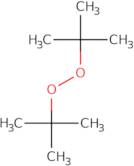Di-tert-butyl peroxide
CAS: 110-05-4
Ref. 3D-FD59851
| 100g | Descontinuado | ||
| 250g | Descontinuado | ||
| 500g | Descontinuado |
Informação sobre produto
- tert-Butyl Peroxide
- 2-(Tert-Butylperoxy)-2-Methylpropane
- B 100924
- B 50Elq
- Bis(1,1-dimethylethyl) peroxide
- Bis(tert-butyl) peroxide
- Cadox TBP
- DTBP (peroxide)
- Di(tertiary-butyl) peroxide
- Di-T-Butyl Peroxide
- Ver mais sinónimos
- Di-t-butylperoxide
- Di-tert-butylperoxid
- Dibutylperoxide
- Dtbp
- Interox DTB
- Kayabutyl D
- Luperox DI
- Nsc 673
- Perbutyl D
- Peroxan DB
- Peroxide, bis(1,1-dimethylethyl)
- Peroxido De Di-Terc-Butilo
- Peroximon DB
- Peroxyde de di-tert-butyle
- TC 4 (catalyst)
- Tc 4
- Tc 4N
- Trigonox?B
- tert-Butyl peroxide
Di-tert-butyl peroxide is a reactive oxygen species that has been used as an oxidant in organic synthesis. It is typically produced by the oxidation of tert-butanol with hydrogen peroxide and sodium citrate. Di-tert-butyl peroxide has been shown to be highly resistant to degradation, even at high pH values. It has also been shown to induce neuronal death in vivo, which may be due to its ability to produce hydroxyl radicals and other reactive oxygen species. Di-tert-butyl peroxide can be used for wastewater treatment because it reacts with organic matter and produces less sludge than chlorine. Di-tert-butyl peroxide also has the ability to react with chemicals in a variety of ways, including transfer reactions, such as the addition of alcohols or esters. The mechanisms of these reactions are still being studied.





